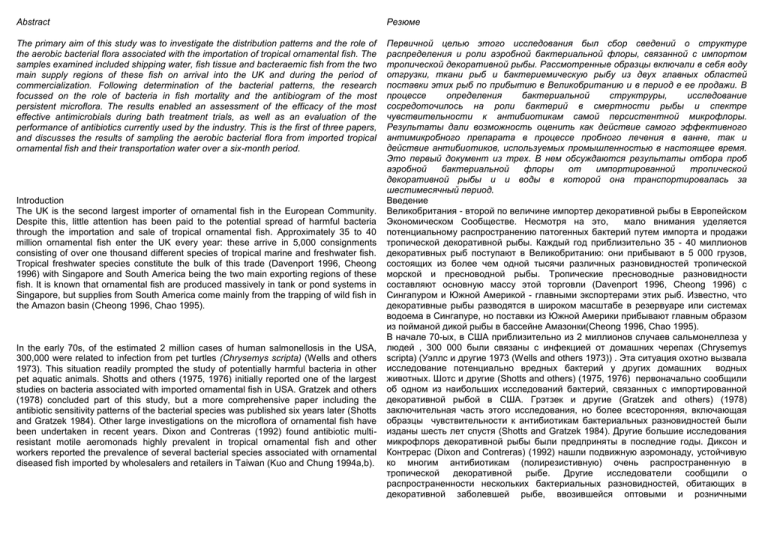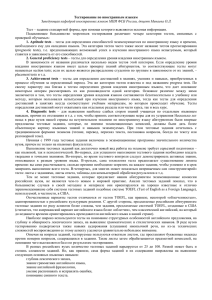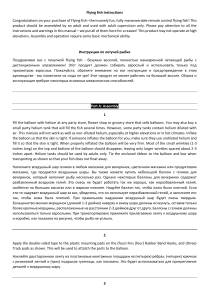Abstract - на Free
advertisement

Abstract Резюме The primary aim of this study was to investigate the distribution patterns and the role of the aerobic bacterial flora associated with the importation of tropical ornamental fish. The samples examined included shipping water, fish tissue and bacteraemic fish from the two main supply regions of these fish on arrival into the UK and during the period of commercialization. Following determination of the bacterial patterns, the research focussed on the role of bacteria in fish mortality and the antibiogram of the most persistent microflora. The results enabled an assessment of the efficacy of the most effective antimicrobials during bath treatment trials, as well as an evaluation of the performance of antibiotics currently used by the industry. This is the first of three papers, and discusses the results of sampling the aerobic bacterial flora from imported tropical ornamental fish and their transportation water over a six-month period. Первичной целью этого исследования был сбор сведений о структуре распределения и роли аэробной бактериальной флоры, связанной с импортом тропической декоративной рыбы. Рассмотренные образцы включали в себя воду отгрузки, ткани рыб и бактериемическую рыбу из двух главных областей поставки этих рыб по прибытию в Великобританию и в период е ее продажи. В процессе определения бактериальной структруры, исследование сосредоточилось на роли бактерий в смертности рыбы и спектре чувствительности к антибиотикам самой персистентной микрофлоры. Результаты дали возможность оценить как действие самого эффективного антимикробного препарата в процессе пробного лечения в ванне, так и действие антибиотиков, используемых промышленностью в настоящее время. Это первый документ из трех. В нем обсуждаются результаты отбора проб аэробной бактериальной флоры от импортированной тропической декоративной рыбы и и воды в которой она транспортировалась за шестимесячный период. Введение Великобритания - второй по величине импортер декоративной рыбы в Европейском Экономическом Сообществе. Несмотря на это, мало внимания уделяется потенциальному распространению патогенных бактерий путем импорта и продажи тропической декоративной рыбы. Каждый год приблизительно 35 - 40 миллионов декоративных рыб поступают в Великобританию: они прибывают в 5 000 грузов, состоящих из более чем одной тысячи различных разновидностей тропической морской и пресноводной рыбы. Тропические пресноводные разновидности составляют основную массу этой торговли (Davenport 1996, Cheong 1996) с Сингапуром и Южной Америкой - главными экспортерами этих рыб. Известно, что декоративные рыбы разводятся в широком масштабе в резервуаре или системах водоема в Сингапуре, но поставки из Южной Америки прибывают главным образом из пойманой дикой рыбы в бассейне Амазонки(Cheong 1996, Chao 1995). В начале 70-ых, в США приблизительно из 2 миллионов случаев сальмонеллеза у людей , 300 000 были связаны с инфекцией от домашних черепах (Chrysemys scripta) (Уэллс и другие 1973 (Wells and others 1973)) . Эта ситуация охотно вызвала исследование потенциально вредных бактерий у других домашних водных животных. Шотс и другие (Shotts and others) (1975, 1976) первоначально сообщили об одном из наибольших исследований бактерий, связанных с импортированной декоративной рыбой в США. Грэтзек и другие (Gratzek and others) (1978) заключительная часть этого исследования, но более всесторонняя, включающая образцы чувствительности к антибиотикам бактериальных разновидностей были изданы шесть лет спустя (Shotts and Gratzek 1984). Другие большие исследования микрофлорs декоративной рыбы были предприняты в последние годы. Диксон и Контрерас (Dixon and Contreras) (1992) нашли подвижную аэромонаду, устойчивую ко многим антибиотикам (полирезистивную) очень распространенную в тропической декоративной рыбе. Другие исследователи сообщили о распространенности нескольких бактериальных разновидностей, обитающих в декоративной заболевшей рыбе, ввозившейся оптовыми и розничными Introduction The UK is the second largest importer of ornamental fish in the European Community. Despite this, little attention has been paid to the potential spread of harmful bacteria through the importation and sale of tropical ornamental fish. Approximately 35 to 40 million ornamental fish enter the UK every year: these arrive in 5,000 consignments consisting of over one thousand different species of tropical marine and freshwater fish. Tropical freshwater species constitute the bulk of this trade (Davenport 1996, Cheong 1996) with Singapore and South America being the two main exporting regions of these fish. It is known that ornamental fish are produced massively in tank or pond systems in Singapore, but supplies from South America come mainly from the trapping of wild fish in the Amazon basin (Cheong 1996, Chao 1995). In the early 70s, of the estimated 2 million cases of human salmonellosis in the USA, 300,000 were related to infection from pet turtles (Chrysemys scripta) (Wells and others 1973). This situation readily prompted the study of potentially harmful bacteria in other pet aquatic animals. Shotts and others (1975, 1976) initially reported one of the largest studies on bacteria associated with imported ornamental fish in USA. Gratzek and others (1978) concluded part of this study, but a more comprehensive paper including the antibiotic sensitivity patterns of the bacterial species was published six years later (Shotts and Gratzek 1984). Other large investigations on the microflora of ornamental fish have been undertaken in recent years. Dixon and Contreras (1992) found antibiotic multiresistant motile aeromonads highly prevalent in tropical ornamental fish and other workers reported the prevalence of several bacterial species associated with ornamental diseased fish imported by wholesalers and retailers in Taiwan (Kuo and Chung 1994a,b). Ornamental fish have also played a minor role in bacterial zoonoses. Isolated cases of septicaemias associated with strains of Edwardsiella tarda, cutaneous mycobacteriosis, liver abscesses and diarrhoea in infants have all been related to ornamental fish (Humphrey and others 1986, Vandepitte and others 1983, Vaishampayan and others 1996). Government agencies and the ornamental fish industry are concerned about the possible introduction of pathogens through the importation of ornamental fish. The ornamental fish industry is also particularly concerned about the mortality rates of imported fish. Ferraz de Oliveira (1995) carried out a parasitology study of South American importations into the UK using a wide range of techniques. One of the results from the study suggested that mortalities are not significantly associated with parasites and may be due to bacterial disease. Recently, the investigation of bacterial diseases affecting coldwater ornamental fish has been undertaken by dedicated researchers in association with government officials. Bacteria would appear to play a very important role in disease problems in koi carp (Cyprinus carpio) causing significant economic losses to British wholesalers (Robertson and Austin 1994, Wildgoose 1998). The current legislation which relates to the importation of ornamental fish varies from country to country. In the UK, the Fish Health Regulations and other related legislation control the importation of all live fish. However, warm-water ornamental species which are intended to be kept permanently in aquaria are not considered to represent a threat to food-fish or native fauna since they are unable to survive in the natural aquatic environment of the UK (MAFF 1995). This paper discusses the findings of a six-month study intended to examine the patterns of the bacterial flora associated with the importation of tropical freshwater ornamental fish on arrival in the UK. This work was carried out in collaboration with the largest importer of tropical ornamental fish in Scotland and with the assistance of the Ornamental Aquatic Trade Association (OATA) Ltd., formerly known as the Ornamental Fish Industry(UK) Ltd. продавцами из Тайваня (Kuo и Chung 1994a, b). Декоративные рыбы также играют незначительную роль в бактериальных зоонозах. Единичные случаи септицемии, связанные с Edwardsiella tarda, кожного микобактериоза, абсцессов печени и диареи у маленьких детей, были все связаны с декоративной рыбкой (Хамфри и другие 1986, Вандерпайт и другие 1983, Вэйшемпэйн и другие 1996 (Humphrey and others 1986, Vandepitte and others 1983, Vaishampayan and others 1996)). Правительственные учреждения и декоративная рыбная промышленность интересуется возможным введением патогенных микроорганизмов путем импорта декоративной рыбы. Декоративная рыбная промышленность также сильно интересуется показателями летальности импортированной рыбы. Феррас де Оливейра (Ferraz de Oliveira) (1995) выполнил паразитологическое исследование южноамериканского импорта в Великобританию, используя широкий диапазон методов. Одно из следствий исследования предположило, что летальности значительно не связаны с паразитами и могут произойти из-за бактериальных болезней. Недавнее, исследование бактериальных болезней декоративной рыбы, возникающих из за холодной воды, было предпринято преданными исследователями в сотрудничестве с правительственными чиновниками. Бактерии, казалось бы, играли бы очень важную роль в проблемах болезни декоративного карпа (koi carp) (Cyprinus carpio) вызывает значительные экономические потери британских оптовых торговцев (Робертсон и Остин 1994, Вайлдгуз 1998 (Robertson and Austin 1994, Wildgoose 1998)). Законодательство, связанное с импортом декоративной рыбы, в каждой стране свое. В Великобритании "Инструкции Здоровья Рыбы" (Fish Health Regulations) и другое связанное законодательство управляют импортом всей живой рыбы. Однако, тепловодные декоративные разновидности, которые предназначены, чтобы быть сохраненными надолго в аквариумах, как полагают, не представляют угрозу промысловой рыбе или врожденной фауне, так как они неспособны остаться в живых в естественной водной среде Великобритания (MAFF 1995). В этой работе рассматриваются результаты шестимесячного исследования, структуры бактериальной флоры, связанной с импортом тропической пресноводной декоративной рыбы прибывшей в Великобританию. Работа была выполнена в сотрудничестве с наибольшим импортером тропической декоративной рыбы в Шотландии и с помощью Декоративной Водной Торговой Ассоциации (Ornamental Aquatic Trade Association (OATA) Ltd) ., прежде известный как Декоративная Рыбная Промышленность (Ornamental Fish Industry (UK) Ltd.)

